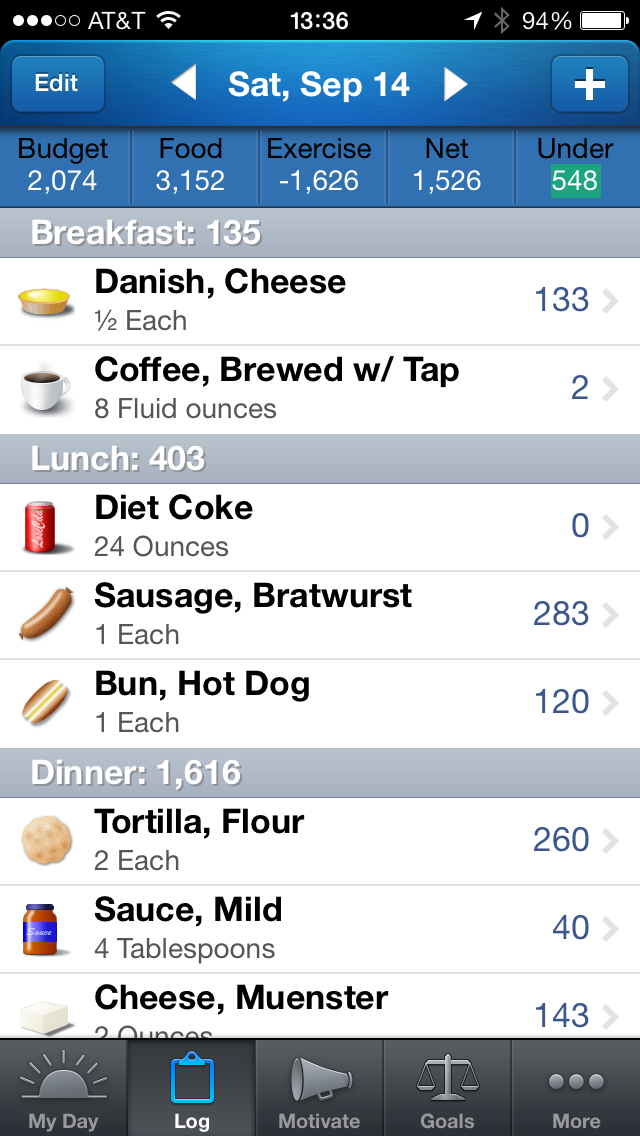
Weight loss isn’t magic. Simply eat less calories than you burn. Easy peasy. That is unless you inadvertently sabotage yourself by getting too geeky and try to use too many nutrition and weight loss Apps to track and manage your progress. I found out the hard way that it’s best to Keep it Simple (Stupid).
The Usual Suspects
How fat am I?
My workflow starts with the Withings Scale. I step on it every morning and it tells me my weight. Because that’s what scales do. But it also connects to my home Wi-Fi network and pushes my weight to Fitbit, Lose It!, Endomondo, and MyFitnessPal. Simple.
How active am I?
I wear a Fitbit Flex. It’s a geeky Bluetooth pedometer that keeps track of my daily activity and steps taken and calculates approximately how many calories I’ve burned. This helps me with meal planning. It syncs with my iPhone throughout the day and pushes my activity and caloric burn total in realtime to Lose It!, Endomondo, and MyFitnessPal. Simple.

How greedy am I?
I use Lose It! to keep track of my caloric intake to plan meals and to keep myself within a 1,000 calorie per day deficit. This is where things start to get less simple.
Using the screenshot on the right as a guide, Lose It! takes my current sex, weight, age, and height and calculates my basal metabolic rate at 3,074 calories (what I can eat per day and not gain or lose weight). I set my caloric budget at a 1,000 calorie deficit (lose 2 pounds per week) so my caloric budget for the day (what I can shove into my cake hole) is 2,074 calories. Simple-ish.
The screenshot shows that my activity for the day has burned about 1,626 calories. So, in theory, I could have eaten 3,700 calories (2,074+1,626) and still lost weight. The app shows that I ended up eating 3,152 calories and was under by 548 calories (1,548 calorie deficit for the day). Simple-ish.
How crazy am I?
I use Endomondo to track the crazy things I do like kayaking and mountain biking. Endomondo is a GPS tracker and more accurately calculates caloric burn for each activity based on GPS movement. Fitbit doesn’t know that I’m kayaking or mountain biking, only that I’m moving, and Endomondo supplements Fitbit with this additional data. Once I upload a GPS track to Endomondo it merges with the data already pushed from Fitbit, does some calculations, merges back to Fitbit, then pushes to MyFitnessPal. Simple-ish.
How stupid am I?
I don’t really use MyFitnessPal. I only signed up because it had some nutritional data that seemed interesting at the time. MyFitnessPal also has an exercise tracker and, after logging exercise, pushes back to Fitbit. Simpl…wait, what? Crap.
How it all went wrong.
Fitbit pushes data to Endomondo. Endomondo nicely merges data with Fitbit but then also pushes to MyFitnessPal. MyFitnessPal pushes duplicate data back to Fitbit. Fitbit sees the MyFitnessPal data as a new workout and pushes both copies of the same data to Lose It!.
So a single 500 calorie workout gets reported twice to Lose It! as a 1,000 calorie workout. Crap.
The moral of the story.
I wasn’t losing nearly as much weight per week as I should have. A 1,000 calorie deficit per day should result in a loss of about 2 pounds per week. I wasn’t anywhere near that even though I was close to my Lose It! calorie budget each day.
Be sure to pay careful attention of how data is being shared to make sure nothing is getting duplicated. There are dozens (hundreds?) of nutrition and weight loss Apps available and I’m sure there are more conflicts similar to this one. Once I disabled MyFitnessPal and deleted two months of duplicate data I’m back on track.
